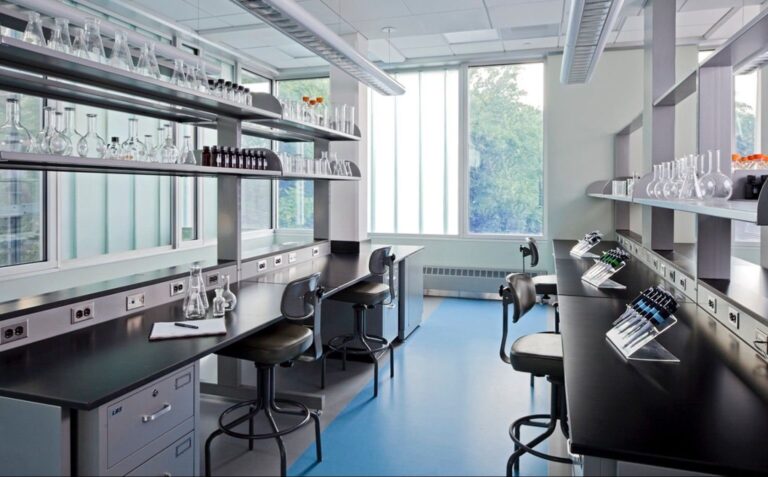
Contents
Designing a laboratory is a complex task that requires careful planning and consideration of various factors to create a safe, efficient, and functional environment. Laboratories are critical spaces for scientific research and development, and their design can significantly impact the quality and success of the work conducted within them. In this comprehensive guide, we will explore the essential elements of laboratory design, including layout, safety, equipment, and workflow optimization.
Understanding the Purpose of the Laboratory Design
The first step Laboratory Design is to understand its purpose and the type of research or experiments that will be conducted. Different types of laboratories such as chemical, biological, clinical, and industrial have unique requirements and specifications. A clear understanding of the laboratory’s purpose will guide all subsequent design decisions.
Space Planning and Layout
Effective space planning is crucial for creating a functional laboratory. The layout should be designed to facilitate smooth workflow, minimize contamination risks, and ensure the safety of personnel. Considerations for space planning include:
Work Zones
Wet and Dry Areas
Separate wet lab areas, where liquid handling and chemical reactions occur, from dry lab areas, where data analysis and electronic work take place.
Storage Areas
Adequate storage for chemicals, reagents, and equipment should be strategically placed to ensure easy access and organization.
Workstations
Ergonomic Design
Workstations should be designed for comfort and efficiency, with adjustable benches and seating to accommodate different tasks and personnel.
Proximity to Utilities
Ensure that workstations are close to necessary utilities such as water, gas, and electrical outlets.
Flow of Movement
Pathways
Design clear and unobstructed pathways to facilitate the movement of personnel and equipment.
Segregation
Separate high-traffic areas from sensitive work zones to reduce the risk of contamination and accidents.
Safety Considerations
Safety is a paramount concern in laboratory design. Implementing robust safety measures protects personnel and ensures compliance with regulatory standards. Key safety features include:
Ventilation
Fume Hoods
Install fume hoods in areas where hazardous chemicals are used to capture and remove airborne contaminants.
HVAC Systems
Design an HVAC system that provides adequate air exchange and filtration to maintain a safe and clean environment.
Emergency Equipment
Eyewash Stations and Showers
Place emergency eyewash stations and safety showers in accessible locations.
Fire Safety
Equip the laboratory with fire extinguishers, fire blankets, and smoke detectors. Ensure that there are clearly marked fire exits.
Chemical Storage
Safety Cabinets
Use safety cabinets for storing flammable, corrosive, and toxic chemicals.
Labeling and Segregation
Clearly label all chemicals and store incompatible substances separately to prevent reactions.
Laboratory Equipment and Furniture
Selecting the right equipment and furniture is essential for the laboratory’s functionality and efficiency. Considerations include:
Benches and Work Surfaces
Durability
Choose materials that are resistant to chemicals, heat, and mechanical damage.
Flexibility
Modular benches that can be reconfigured as needed provide versatility for changing research needs.
Specialized Equipment
Instrument Placement
Position large and frequently used instruments in accessible locations to streamline workflow.
Maintenance Access
Ensure that there is sufficient space around equipment for maintenance and repair activities.
Technology Integration
Modern laboratories rely heavily on technology for data collection, analysis, and communication. Integrating technology into the laboratory design enhances productivity and accuracy.
Automation
Incorporate automated systems for repetitive tasks such as sample handling, liquid dispensing, and data recording to improve efficiency and reduce human error.
Sustainability and Energy Efficiency
Sustainable laboratory design reduces environmental impact and operational costs. Considerations for sustainability include:
Energy Efficiency
Use energy-efficient lighting such as LED fixtures and incorporate natural light where possible. Select energy-efficient laboratory equipment and appliances.
Workflow Optimization
Optimizing workflow is essential for maximizing productivity and ensuring that research activities proceed smoothly.
Process Mapping
Map out key research processes to identify bottlenecks and areas for improvement. Design the laboratory layout and workflow to minimize unnecessary movement and delays.
Conclusion
Designing a laboratory involves careful consideration of various factors to create a safe, efficient, and functional space for scientific research. By focusing on space planning, safety, equipment selection, technology integration, sustainability, workflow optimization, and compliance, you can create an optimal laboratory environment that supports high-quality research and development. With the right laboratory solution, you can ensure that your research activities are conducted in a well-organized, safe, and efficient manner, ultimately contributing to scientific advancements and discoveries.